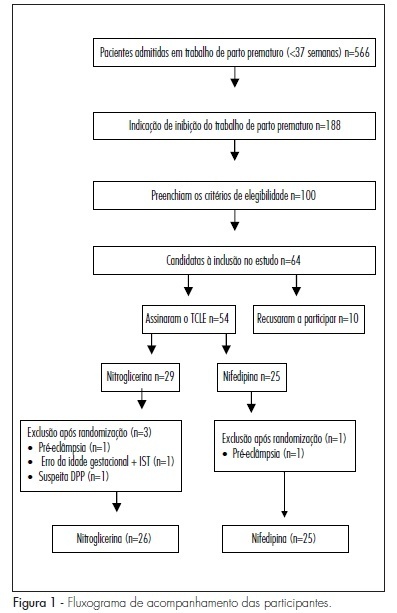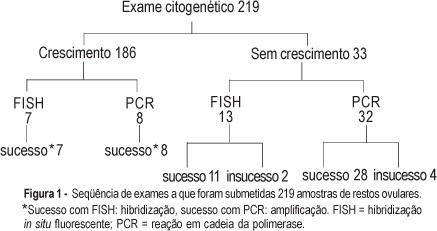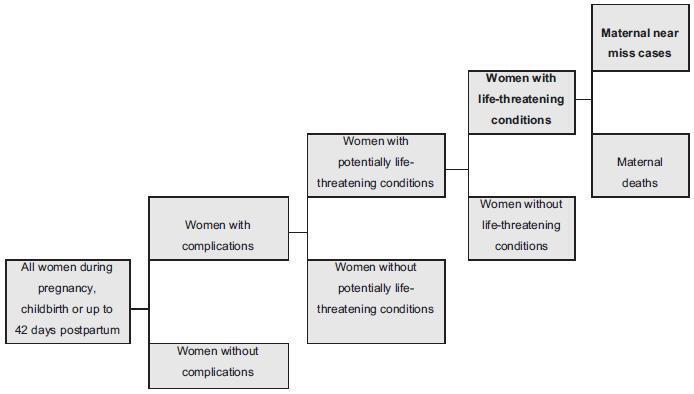Summary
Revista Brasileira de Ginecologia e Obstetrícia. 2009;31(11):552-558
DOI 10.1590/S0100-72032009001100005
PURPOSE: to compare the effectiveness of transdermal nitroglycerin with oral nifedipine in the inhibition of preterm delivery. METHODS: a clinical essay has been performed with 50 women in preterm delivery, randomly divided into two groups, 24 receiving oral nifedipine (20 mg), and 26, transdermal nitroglycerin (10 mg patch). Patients with a single gestation, between the 24th and the 34th weeks and diagnosis of preterm delivery were selected. Women with fetal malformation and clinical or obstetric diseases were excluded. The variables analyzed were: effective tocolysis, time needed for tocolysis, recurrence frequency, progression to preterm delivery, and side effects. RESULTS: tocolysis efficacy in the first 12 hours was similar between the groups (nitroglycerin: 84.6% versus nifedipine: 87.5%; p=0.50). The time average time needed for tocolysis was also similar (6.6 versus 5.8 hours; p=0.30). There was no difference between the groups, concerning the recurrence of preterm delivery (26.9 versus 16.7%; p=0.30), and neither in the rate of preterm delivery within 48 hours (15.4 versus 12.5%; p=0.50). Nevertheless, the cephalea rate was significantly higher in the Nitroglycerin Group (30.8 versus 8.3%; p=0.04). CONCLUSIONS: transdermal nitroglycerin has presented similar effectiveness to oral nifedipine to inhibit preterm delivery in the first 48 hours, however with higher cephalea frequency.

Summary
Revista Brasileira de Ginecologia e Obstetrícia. 2001;23(9):553-558
DOI 10.1590/S0100-72032001000900002
Purpose: to evaluate the role of routine obstetrical ultrasound scan in suspecting the presence of fetal congenital heart diseases and severe arrhythmias, as well as the factors involved in its accuracy. Methods: the sample was made up of 77 neonates and infants hospitalized at the Institute of Cardiology of Rio Grande do Sul from May to October of 2000, with confirmed postnatal diagnosis of structural heart disease or severe arrhythmia, whose mothers had been submitted to at least one obstetrical ultrasound scan after 18 weeks of gestation. After informed consent, a customized standard questionnaire was used. Categorical variables were compared using chi² test or Fisher's exact test and a logistic regression model was used to determine independent variables possibly involved in the prenatal suspicion of cardiac abnormalities. Results: in 19 patients (24.6%), obstetrical ultrasound was able to rise prenatal suspicion of structural or rhythm abnormalities. Considering only congenital heart diseases, this prevalence was 19.2% (14/73). In 73.7% of these cases, the cardiac disorder was accessible by the four-chamber view alone. Arrhythmias during obstetrical scan were observed in 26.3 of the babies with prenatal suspicion of a heart abnormality, while only 3.4% of the patients without prenatal suspicion showed a rhythm alteration (p=0.009). Significant differences between the groups with and without prenatal suspicion of cardiac abnormalities were observed in relation to parity (p=0.029), delivery by cesarean section (p=0.006), need for intensive care (p=0.046) and school education level of the father (p=0.014). At multivariate analysis, only the presence of a rhythm alteration during ultrasound scan was shown to be an independent variable associated with prenatal suspicion of cardiac abnormalities. Conclusions: routine obstetrical ultrasound has been underused in prenatal screening of congenital heart diseases. Adequate training and making obstetricians and the population a ware of the problem may be instruments for increasing the efficacy of routine obstetrical ultrasound in rising the suspicion of fetal cardiac abnormalities.
Summary
Revista Brasileira de Ginecologia e Obstetrícia. 2003;25(8):553-559
DOI 10.1590/S0100-72032003000800003
PURPOSE: to verify vitrification techniques using 6 M DMSO to cryopreserve in vitro matured bovine oocytes, and to assess the effects of the time of exposure to vitrification solutions (VS). METHODS: dilutions of VS were prepared from the stock VS (VS 100%) consisting of 6 M DMSO to give 25 and 65% DMSO solutions. Bovine oocytes were in vitro matured for 18-22 h. Matured oocytes were placed first into 25% VS, at room temperature for 5 min, then transferred to 65% VS, before being pipetted into the 100% VS in plastic straws. Three experimental groups were formed: in the first group, time of pipetting through 65% VS and loading the straw took up to 60 s, in the second group it did not exceed 30 s. For thawing, straws were held in air for 10 s and then in a water bath for 10 s. The contents of each straw were expelled in sucrose solution and held for 5 min. In the third experimental group, oocytes went through all VS, but were not vitrified. All retrieved oocytes were inseminated. For control, fresh, in vitro matured oocytes were inseminated. RESULTS: after vitrification, 69.1 and 59.8% of the oocytes were retrieved from the 30 s and 60 s groups, respectively, and 93 and 89% of these oocytes appeared morphologically normal 24 h after insemination, respectively. In the group of oocytes exposed without vitrification, 75.6% were retrieved and 84.7% were morphologically viable, 24 h after insemination. No fertilization was observed in the experimental groups. Among controls, 65.4% were fertilized. CONCLUSIONS: the vitrification technique using 6 M DMSO is not a feasible approach to cryopreserve in vitro matured bovine oocytes. Decreasing the time of exposure to VS did not overcome deleterious effects of the procedure on the fertilizability of oocytes. Improvements in the technique are needed to protect the zona pellucida and oolemma.
Summary
Revista Brasileira de Ginecologia e Obstetrícia. 2005;27(9):554-560
DOI 10.1590/S0100-72032005000900009
PURPOSE: to evaluate the performance of cytogenetic analysis, fluorescent in situ hybridization (FISH) and polymerase chain reaction (PCR) in the study of numerical chromosomal anomalies and in fetal sex determination of spontaneous abortion material. METHODS: cytogenetic analysis was performed on 219 spontaneous abortion specimens. Forty of these cases were also submitted to fetal sex determination using nested-PCR. Thirty-two of these cases were selected due to failed cytogenetic culture and the other eight were selected randomly. Twenty samples were submitted to the FISH technique, using probes for chromosomes 13, 18, 21, X and Y. Thirteen of these samples were selected due to failed cytogenetic culture and the other seven were randomly selected. The success rates of each technique were compared using the chi2 test and an established p<0.05 level of significance. The results of samples submitted to more than one test were evaluated for accuracy, using the cytogenetic result as the gold standard. RESULTS: cytogenetic analysis was successful in 84.9% of the samples and in 51.1% of them the results were abnormal: 65.2% trisomy, 17.9% triploidy, 9.4% tetraploidy, 4.2% chromosome X monosomy, and 1.1% each for double trisomy, tetrasomy and structural abnormality. The most frequent trisomy was that of chromosome 16 (39%). The success rate of FISH and PCR techniques (90%) did nod differ significantly from the cytogenetic analysis. In all cases submitted to more than one test, the results were identical to those obtained through cytogenetic analysis. Samples that failed to grow on cytogenetic test and that were submitted to other techniques of molecular biology had a success rate of 87.5 and 84.6% for PCR and FISH, respectively. CONCLUSION: cytogenetic analysis of spontaneous abortions had a high success rate and chromosomal anomalies were identified in over half of the cases. Molecular biology techniques (PCR and FISH) complemented the cytogenetic study and proved to be reliable in the detection of numerical chromosomal anomalies and in fetal sex determination.

Summary
Revista Brasileira de Ginecologia e Obstetrícia. 2013;35(12):554-561
DOI 10.1590/S0100-72032013001200005
PURPOSE: To investigate the etiology and the epidemiological profile of patients with vulvovaginal candidiasis (VVC) and predisposing factors. METHODS: Vaginal secretions were streaked in Sabouraud agar and yeast samples were isolated and identified by Polymerase Chain Reaction (PCR). Demographic and clinical data were obtained with a questionnaire. For statistical analysis, the Student's t-test, the χ² and Fischer tests were applied as needed using the Statistical Package for Social Sciences (SPSS) software, with the level of significance set at 5%. RESULTS: Sixty-nine patients aged from 15 to 52 years were evaluated. They were predominantly white (79.7%), with higher education (58%), married (56.5%) and sexually active (97.1%). Among them, 34.8% were pregnant, 7.2% diabetic, 1.4% seropositive for AIDS, and 36.2% were using oral contraceptives. Recent antibiotic therapy was mentioned by 13% of the patients, and antifungal or anti-trichomonas therapy was mentioned by 5.8 and 1.4% of the patients, respectively. Corticosteroid use was reported by 2.9% and antineoplastic by 1.4%. Vaginal discharge and itching were the main complaints (97.1 and 73.9%), followed by burning (63.8%) and erythema (63.8%). When present, the vaginal flow was predominantly white (88.1%) or lumpy (86.6%). The diagnosis was confirmed by culture in 55 (79.7%) patients, with mixed infections in 4 patients. The most prevalent species was C. albicans, followed by C. glabrata (one monoinfection and two mixed infections with C. albicans). C. lusitaniae and C. albicans were also identified in mixed infections (two patients). CONCLUSION: Despite the high culture positivity and clinical data characteristic of VVC, the symptoms were not pathognomonic. C. albicans is the most prevalent species, but other species are also involved in VVC etiology, such as the emergence of C. lusitaniae.
Summary
Revista Brasileira de Ginecologia e Obstetrícia. 2018;40(9):554-562
Twin pregnancy accounts for 2 to 4% of total births, with a prevalence ranging from 0.9 to 2.4% in Brazil. It is associated with worse maternal and perinatal outcomes. Many conditions, such as severe maternal morbidity (SMM) (potentially life-threatening conditions and maternal near-miss) and neonatal near-miss (NNM) still have not been properly investigated in the literature. The difficulty in determining the conditions associated with twin pregnancy probably lies in its relatively low occurrence and the need for larger population studies. The use of the whole population and of databases from large multicenter studies, therefore, may provide unprecedented results. Since it is a rare condition, it ismore easily evaluated using vital statistics from birth e-registries. Therefore, we have performed a literature review to identify the characteristics of twin pregnancy in Brazil and worldwide. Twin pregnancy has consistently been associated with SMM, maternal near-miss (MNM) and perinatal morbidity, with still worse results for the second twin, possibly due to some characteristics of the delivery, including safety and availability of appropriate obstetric care to women at a high risk of perinatal complications.

Summary
Revista Brasileira de Ginecologia e Obstetrícia. 2007;29(11):555-560
DOI 10.1590/S0100-72032007001100002
PURPOSE: to identify the factors related to successful gestational diabetes mellitus (GDM) management with glyburide and to evaluate perinatal outcomes. METHODS: prospective longitudinal study including 50 pregnant women with GDM who required complementary treatment to diet and physical activity, whose fetus presented normal abdominal circumference (AC) to ultrasound (pct<75). Study period was August 2005 to July 2006. Ultrasonography was carried out monthly. Glyburide was used until delivery, as long as glucose control was obtained and fetal AC was normal, being thus considered therapeutically successful. In case there was no glucose control or alteration in AC, management was switched to insulin therapy, being thus considered therapeutically unsuccessful. Pregnant women were divided into two groups: one therapeutically successful (n=29) and another therapeutically unsuccessful (n=21). The results evaluated were: therapeutic success, maternal characteristics and perinatal outcome. RESULTS: fifty-eight percent of the cases were successfully managed with glyburide. No difference was found (p>0.05) in either group, with regards to maternal age, glucose values at OGTT75g, maternal body mass index (BMI), number of pre-natal consultations, number of previous pregnancies. According to the logistic model of regression used, therapeutically successful pregnant patients had had a later diagnosis (p=0.02) and lower weight gain during gestation (p<0.01). Perinatal outcome did not differ in either group. CONCLUSIONS: patients with later diagnosis and lower weight gain are more likely to have successful GDM management with glyburide. Unsuccessful management with glyburide did not alter the perinatal outcome.